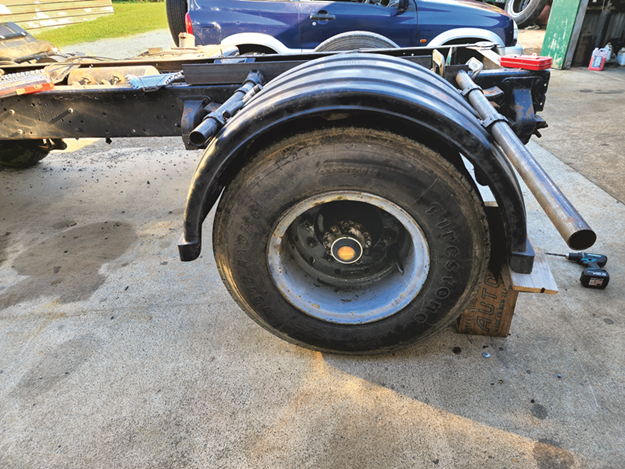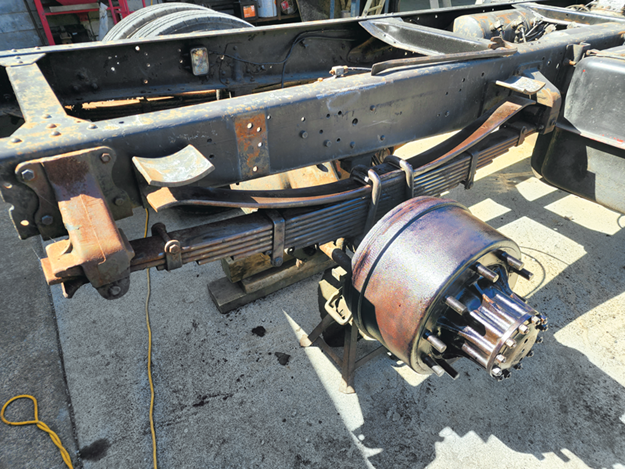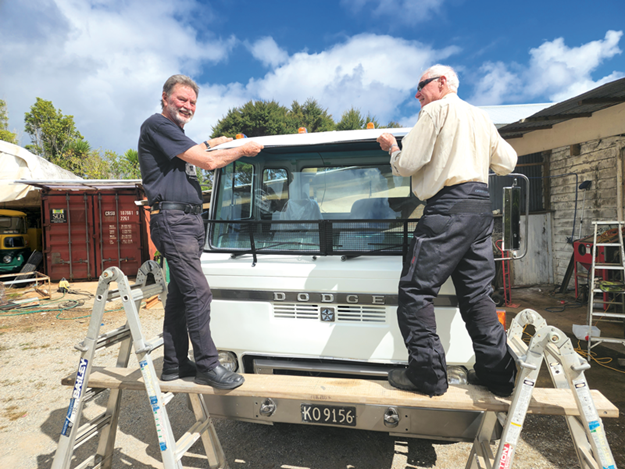Restoration: Dodge — Part 25
Last month, Lyndsay said the riddle of how he was supposed to be moving forward with the restoration would be answered. He’s somehow found a way of going forward while working backwards.
 |
|
The sun visor adds a finishing touch
|
The answer to the conundrum lay in last month’s photo of me holding an impact wrench to what was obviously a set of rear wheels. That’s right, after months of working on the cab end of the truck, believe it or not, I’ve finally got my act together and have made a start on the back of the old Dodge, the first part of which is to fit a pair of rear mudguards.
 |
|
Fabricating brackets for the left-hand rear mudguard
|
About a year ago, I was talking to Colin Dunn at his Rainbow Haulage yard when I spotted a pair of rotationally moulded guards looking lonely in a corner of the yard.
 |
|
Setting up the rear guards wasn’t as easy as I imagined
|
I asked Colin if he would be willing to sell them, but he said I could have them if I wanted. I didn’t waste any time in accepting his generous offer and soon was back with a trailer. The guards came complete with fixings.
As would be expected, when offering the units up to the truck, the mounting brackets didn’t fit perfectly to the chassis, thus a little Kiwi ingenuity and modest engineering were the order of the day.
Should it be a tractor unit?
 |
|
Let the rear end tidy-up begin
|
Given the shortness of the truck’s wheelbase, my thoughts of the eventual purpose to which the rig will be put still tend to revolve around making it into a tractor unit.
Along with some of my closest mates, I’ve bandied a lot of options around: ideas such as a water cart and a crane unit, but as I already have a tow wagon in the form of my little FGK 30 Morris, the latter idea has been canned.
My old mate Noel Galloway spied a short wheelbase Hi Line Commer with a tipping body sitting in a paddock in the lower North Island that he thinks he could acquire for my project, but the jury’s still out as to whether it’d be a viable proposition.
I’m still weighing the pros and cons of the various configurations the vehicle could end up in, and I have to say that time is running out to make the final decision.
Pressure is on
The pressure is now well and truly on because I’ve promised that this restoration is going to be done and dusted by no later than September this year. As bad as my arithmetic is, even I can figure that between now and September, we’re roughly half a year away from completion.
Getting the brakes up to standard
It’s fair to state that there isn’t much left to do to complete the cab. With the fitting of the rear mudguards underway, the only aesthetic work that remains involves a lot of cleaning and painting, which seems to be my forte. What worries me is the mechanical work that still needs to be done.
The easiest part of the mechanical side of things is getting the alternator going. All that involves is removing it from the truck and sending it off for repair or replacing it with a new one — job done, that part at least.
The problems will start to arise when it comes to getting the brakes up to a standard where I can realistically present the truck at the testing station.
There’s also an oil leak issue that will have to be attended to. While I haven’t given any real thought as to where exactly the oil’s leaking from, you can bet your bottom dollar it won’t be an easy fix.
Two pairs of extra hands required
 |
|
Ian Hambly and the Colonel (AKA Evan Taylor) lending a hand
|
A restoration is always made more interesting when you mix the work up a little. To that end, I took a break a couple of weeks ago when I invited two mates, the Colonel AKA Evan Taylor and Ian Hambly around to give me a hand to fit the sun visor.
The previous month, these guys assisted with fitting the stoneguard, and I’m sorry but I neglected to officially thank them for their previous effort — thanks guys this time around.
As for me, well, I’ve finally accepted that some jobs require more than one person. I’m still kicking myself for a bad decision made a couple of years ago when refitting the stoneguard to the Mitsubishi transporter.
I’d done what I thought was a half-decent job of turning the truck from an insipid blue into the metallic dark green it currently sports and had given the paintwork a week or so to cure before attempting to fit the stoneguard.
Not wanting to disturb anyone else, I elected to do the job on my own, which turned out to be a bad decision.
The truck still bears the scratches to this very day, and although it’s gathered a few extra battle scars over the past couple of years, which kind of masks the scratches inflicted upon it due to my incompetence, I’ve learned the lesson to not try and fit larger items on my own.
Custodians of vehicles
At the risk of stating the obvious, I believe that all of us who have an interest in historic-type vehicles are merely custodians of the cars and trucks we purportedly own.
To that end, there are a number of additional measures we can take to give a little bit of extra assurance that these representations of our transport history will endure once we’ve exited this mortal coil.
I know some folks will find the preceding statement somewhat glib, but in any event, I hope I’ve done my bit to hopefully save some of my contributions to the effort from becoming extinct. Let me explain.
The Vintage Car Club of New Zealand’s Historic Vehicle Authority keeps a register of historic cars and commercial vehicles that are 40 years and older.
Private individuals are invited to submit applications to the Authority to be identified as being artefacts of specific significance to our motoring and transport heritage.
The modus operandi of this unique means of vehicle identification is way beyond the scope of this article, however, the ‘VIC’ Register, as it’s known, certainly adds an upper level of provenance to any vehicle’s status should it pass the stringent test expected by the Authority.
Where this is all leading is that two of my previous restorations, the 1953 K Bedford and the 1964 FGK30 Morris tow wagon have joined my 1929 K DeSoto car in this most exclusive club, hopefully, leading the charge for the Dodge to join them in the not-too-distant future.
In the meantime, it’s back to the workshop to continue the RG13’s journey, working on the back end of the truck.
Find new and used heavy machinery for sale in NZ
Keep up to date in the industry by signing up to Deals on Wheels' free newsletter or liking us on Facebook.


.jpg)



.jpg)


.jpg)

.png)
.png)
.png)
.png)
.png)

